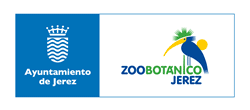Colección de animales vivos, Zoobotánico de Jerez
-
Code
ZBJ-AV -
Registration date
22/08/2007 -
Update date
08/02/2016 - Download the sheet
Description
Parque zoológico tradicional creado en 1953. La colección zoológica presenta aves, mamíferos y reptiles de todas las partes del mundo si bien, nuestro centro está especializado en fauna mediterránea amenazada.Overall information
Goals
Preservation of animal species, scientific reseach and educational and ludic function
Strengths
Fauna meditérranea amenazada.
How to cite
Colección de animales vivos, Zoobotánico de Jerez
Usage restrictions
Las condiciones que marcan las cuestiones bioéticas.
Access restrictions
Entrada del público en general tras el pago de una entrada. Los investigadores pueden acceder libremente a desarrollar sus investigaciones.
Common names
Aves, mamíferos y reptiles.
Geospatial coverage
Mundial, si bien estamos especializados en fauna mediterránea amenazada.
Temporal location
Temporal coverage
todo(s) taxón existente.
Collection period
Continua desde su fundación.
Datasets of the collection/database
Types of objects
todo(s) organismos enteros.
Types of datasets
todo(s) observaciones.
Conservation method
todo(s) sin tratamiento.
Digitalization
Nº of copies / records
900
Nº of species
300
Percentage of computerization
100
Does it include Type specimens?
No
Related Resources
Publications
- 01. Cuadrado M. 2004. Signed a collaboration agreement between ZooBotánico Jerez and Estación Biológica de Doñana (CSIC) EAZA News 43, 13.
- 02. Cuadrado M., Díaz-Paniagua C., Quevedo M.A., Aguilar J.M. & Molina Prescott I. 2002. Hematology and clinical chemistry in dystocic and healthy post-reproductive female chameleons. J. Wildlife Diseases 38, 395-401.
- 03. Cuadrado M., Molina-Prescott I. & Flores L. 2003. Comparative method of blood sampling collection in chameleons. Veterinary Journal 166, 93-97.
- 04. Fernández J, Enseñat C, Quevedo M.A. & Aguilar J.M. 1993. Use of neurolaptic agents in the control of intraspecific aggression in great apes. Proceedings of American Association of Zoo Veterinarians 1993, 139-140.
- 05. Galka E.M., Aguilar J.M., Quevedo M.A. Santiesteban J.M., & Gómez-Villamandos R.J 1999. Alpha-2 agonist dissociative anesthetic combinations in fallow deer (Cervus dama). Journal of Zoo and Wildlife Medicine 30, 451-453.
- 06. Gañán N., A. Sestelo, J. J. Garde, F. Martínez, A.Vargas, I. Sánchez, M. J. Pérez-Aspa, J.V. López-Bao, F. Palomares, M. Gomendio and E. R. S. Roldán. 2010. Reproductive traits in captive and free-ranging males of the critically endangered Iberian lynx (Lynx pardinus). Reproduction (2010) 139: 275-285.
- 07. Gañán N., González R., Sestelo A., Garde J.J., Sánchez I., Aguilar J.M., Gomendio M. & Roldán E.R.S. 2009. Male reproductive traits, semen cryopreservation, and heterelogous in vitro fertilization in the Bobcat (Lynx rufus). Theriology.
- 08. Gómez-Villamandos J.C. Hervás J., Salguero F.J., Quevedo M.A., Aguilar J.M. & Mozos E. 1998. Haemorrhagic enteritis associates with herpesvirus in storks. Avian pathology 27, 229-236.
- 09. Green A.J., M.I. Sánchez, F. Amat, J. Figuerola, F. Hontoria, O. Ruiz, F. Hortas. 2005. Dispersal of invasive and native brine shrimps Artemia (Anostraca) via waterbirds. Limnology and Oceanography 50 (2): 737-742.
- 10. López P., Martín J. & Cuadrado M. 2003. Chemosensory cues allow male lizards Psammodromus algirus to override visual concealment of sexual identity by satellite males. Behavioural Ecology Sociobiology 54, 218-224.
- 11. López P., Martín J. & Cuadrado M. 2004. The role of lateral spots in intrasexual relationships between male Iberian Rock lizards, Lacerta monticola. Ethology 110, 543-561.
- 12. Margalida, A. & A.B. Marín-Arroyo. 2013. Dietary habits in the endangered Bearded Vulture Gypaetus barbatus from Upper Pleistocene to modern times in Spain: a paleobiological conservation perspective. Bird Conservation International, 23: 469-476.
- 13. Negro J.J., Garrido-Fernández, J. 2000. Astaxanthin is the major carotenoid in tissues of white storks (Ciconia ciconia) feeding on introduced crayfish (Procambarus clarkii). Comp. Biochem Physiol B Biochem Mol Biol, 126 (3): 347-52.
- 14. Negro J.J., Grande J.M., Tella J.L., Garrido J., Hornero D., Donazar J.A., Sánchez-Zapata J.A., Benítez J.R., Barcell M. 2002. An unusual source of essential carotenoids. Nature 516, 807-808.
- 15. Quevedo Muñoz, M.A.; J.M. López Vázquez & E. Aguilera Prieto (2006): Update on Proyecto eremita. Northern Bald Ibis conservation and reintroduction workshop 2006: 64-66.
- 16. Sánchez I. & Cuadrado M. 2006. Reproduction of Cabrera vole at Zoo Jerez. EAZA News 55, 17.
- 17. Tallo-Parra O., Carbajal A., Sabes-Alsina M., Almagro V., Fernández-Bellón H., Enseñat C, Quevedo M.A. Manteca X. & Abáigar T. 2013. Preliminary results on hair cortisol detection as a tool to evaluate chronic stress in Saharawi dorcas gazelle (Gazella dorcas neglecta), 9th International Conference on Behaviour, Physiology and Genetics of Wildlife, Conference Proceedings: 193. Berlin.
- 18. Vargas A., I. Sánchez, F. Martínez, A. Rivas, J.A. Godoy, E. Roldán, M.A. Simón, R. Serra, M.J. Pérez, C. Enseñat, M. Delibes, M. Aymerich, A. Sliwa & U. Breitenmoser. 2008. The Iberian Lynx Lynx pardinus Conservation Breeding Program. International Zoo Yearbook, (2008) 42: 190-198.

